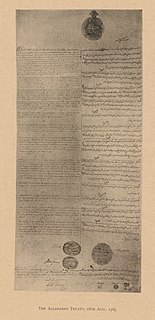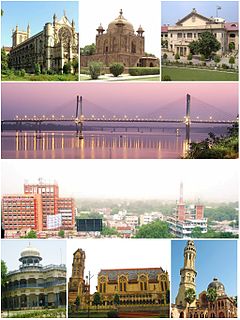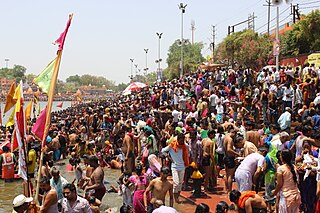Related Research Articles

Kumbh Mela or Kumbha Mela is a major pilgrimage and festival in Hinduism. It is celebrated in a cycle of approximately 12 years, to celebrate every revolution Brihaspati (Jupiter) completes, at four river-bank pilgrimage sites: Allahabad, Haridwar (Ganges), Nashik (Godavari), and Ujjain (Shipra). The festival is marked by a ritual dip in the waters, but it is also a celebration of community commerce with numerous fairs, education, religious discourses by saints, mass gatherings of monks, and entertainment spectacle. The seekers believe that bathing in these rivers is a means to prāyaścitta for past mistakes, and that it cleanses them of their sins.
Prayag is a historical name of the area near the confluence of the Ganges and Yamuna rivers in the modern-day city of Allahabad in northern India.

Allahabad district, officially known as Prayagraj district, is the most populous district of Uttar Pradesh state of India. The district headquarters is Allahabad which was renamed Prayagraj at the same time as the district was renamed. The District is divided into blocks within tehsils. As of 2011, there are 20 blocks in eight tehsils. The Allahabad division includes the districts of Pratapgarh, Fatehpur, Kaushambi and Allahabad, with some western parts that had previously part of Allahabad District becoming part of the new Kaushambi District. The administrative divisions are Phulpur, Koraon, Meja, Sadar, Soraon, Handia, Bara, Shringverpur and Karchana.

Allahabad Fort is a fort built by the Mughal emperor Akbar at Allahabad, Uttar Pradesh, India in 1583. A stone inscription inside fort describe 1583 as a foundation year. The fort stands on the banks of the Yamuna near its confluence with the river Ganges. It is recognised by the Archaeological Survey of India as a monument of national importance.
Jhusi or Jhunsi is a town and a part of Allahabad municipal corporation in Allahabad district in the Indian state of Uttar Pradesh. It was formerly called Pratishthan Pur or Puri.

The Treaty of Allahabad was signed on 12 August 1765, between the Mughal Emperor Shah Alam II, son of the late Emperor Alamgir II, and Robert Clive, of the East India Company, in the aftermath of the Battle of Buxar of 23 October 1764. The treaty was handwritten by I'tisam-ud-Din, a Bengali Muslim scribe and diplomat to the Mughal Empire.

Prayag is an ancient holy city of India mentioned in the Vedic scriptures and texts. Prayag was renamed Allahabad by the Mughal ruler Akbar around 1575 or even later. Akbar was grandson of the Mughal conqueror Babur.

Allahabad, officially known as Prayagraj, also known as Ilahabad, is a metropolis in the Indian state of Uttar Pradesh. It is the administrative headquarters of the Allahabad district—the most populous district in the state and 13th most populous district in India—and the Allahabad division. The city is the judicial capital of Uttar Pradesh with the Allahabad High Court being the highest judicial body in the state. As of 2011, Allahabad is the seventh most populous city in the state, thirteenth in Northern India and thirty-sixth in India, with an estimated population of 1.53 million in the city. In 2011 it was ranked the world's 40th fastest-growing city. Allahabad, in 2016, was also ranked the third most liveable urban agglomeration in the state and sixteenth in the country. Hindi is the most widely spoken language in the city.
1954 Kumbh Mela stampede occurred in 1954 at Kumbha Mela on 3 February 1954 in Allahabad in Uttar Pradesh state in India. It was the main bathing day of Mauni Amavasya, when the incident took place. During the festival 4–5 million pilgrims had taken part that year, which was also the first Kumbh Mela after the Independence.

Ram Chandra Chatterjee was first Indian aeronaut to fly solo. He is also an acrobat, gymnast, balloonist, parachutist and patriot. He was the first Indian to fly in a balloon and land in a parachute. He was also the first Indian to take up ballooning as a profession. His daring acts with the balloon and the parachute made him a national hero.

The Allahabad pillar is a Stambha, containing one of the Pillar edicts of Ashoka, possibly erected by Ashoka, Emperor of the Maurya dynasty, who reigned in the 3rd century BCE or it may have prior origins. While it is one of the few extant pillars that carry Ashokan edicts, it is particularly notable for containing later inscriptions attributed to the Gupta emperor Samudragupta. Also engraved on the stone are inscriptions by the Mughal emperor Jahangir, from the 17th century.

Prayagraj Junction, previously known as Allahabad Junction, is a railway station on the Howrah–Delhi main line, Allahabad–Mau–Gorakhpur main line and Howrah–Allahabad–Mumbai line. It is the headquarters of the North Central Railway zone. It is located in Allahabad in the Indian state of Uttar Pradesh. It serves Allahabad and the surrounding areas.

The Kumbh Mela at Haridwar is a mela held every 12 years at Haridwar, India. The exact date is determined according to Hindu astrology: the Mela is held when Jupiter is in Aquarius and the Sun enters Aries.

Ujjain Simhastha is a Hindu religious mela held every 12 years in the Ujjain city of Madhya Pradesh, India. The name is also transliterated as Sinhastha or Singhastha. In Hindi, the fair is also called Simhasth or Sinhasth. The name derives from the fact that it is held when the Jupiter is in Leo.

Nashik-Trimbakeshwar Simhastha is a Hindu religious mela held every 12 years in the Nashik district of Maharashtra, India. The name of the festival is also transliterated as Sinhastha or Singhastha. It is one of the four fairs traditionally recognized as Kumbha Melas, and is also known as Nashik-Trimbak Kumbha Mela or Nashik Kumbha Mela.
The Allahabad Kumbh Mela, also Prayag Kumbh Mela, is a mela, or religious gathering, associated with Hinduism and held in the city of Allahabad, India, at the Prayag or Triveni Sangam—which represents the confluence of three rivers two of which, the Ganges and the Yamuna, have objective existence, and one, the Sarasvati is mythical. The festival is marked by a ritual dip in the waters, but it is also a celebration of community commerce with numerous fairs, education, religious discourses by saints, mass feedings of monks or the poor, and entertainment spectacle. Approximately 50 and 30 million people attended the Allahabad Ardh Kumbh Mela in 2019 and Maha Kumbh Mela in 2013 respectively to bathe in the holy river Ganges, making them the largest peaceful gathering events in the world.

The 2019 Prayagraj Ardh Kumbh Mela was the Ardh Kumbh Mela held at Triveni Sangam in Allahabad, Uttar Pradesh, India from 15 January to 4 March 2019.
Gabriel Boughton was an East India Company (EIC) ship surgeon who travelled to India in the first half of the seventeenth century and became highly regarded by Mughal royalty.
References
- ↑ Shiva Kumar Dubey (2001). Kumbh city Prayag. Centre for Cultural Resources and Training. pp. 31–41. Retrieved 4 November 2014.
- 1 2 Bhatia, H. S. (1 January 2008). Military History of British India, 1607-1947. Deep and Deep Publications. p. 95. ISBN 9788184500790 . Retrieved 2 November 2014.
- ↑ Bhattacherje, S. B. (1 May 2009). Encyclopaedia of Indian Events & Dates. Sterling Publishers Pvt. Ltd. pp. A-16. ISBN 9788120740747 . Retrieved 24 March 2014.
- ↑ Buddhist Records of the Western World, Book V Archived 2016-03-04 at the Wayback Machine by Xuan Zang
- ↑ Dilip Kumar Roy; Indira Devi (1955). Kumbha: India's ageless festival. Bharatiya Vidya Bhavan. p. xxii.
- ↑ Vikram Doctor (10 February 2013). "Kumbh mela dates back to mid-19th century, shows research". Economic Times.
- ↑ Kama MacLean (August 2003). "Making the Colonial State Work for You: The Modern Beginnings of the Ancient Kumbh Mela in Allahabad". The Journal of Asian Studies. 62 (3): 873–905. doi:10.2307/3591863. JSTOR 3591863.
- ↑ Bhattacherje, S. B. (1 May 2009). Encyclopaedia of Indian Events & Dates. Sterling Publishers Pvt. Ltd. p. 21. ISBN 9788120740747 . Retrieved 24 March 2014.
- ↑ The Imperial Gazetteer of India v. 5 (New ed.). Clarendon Press. p. 299. Retrieved 6 November 2014.
- 1 2 3 4 5 Bhatia, H. S. (1 January 2008). Military History of British India, 1607-1947. Deep and Deep Publications. p. 96. ISBN 9788184500790 . Retrieved 2 November 2014.
- ↑ Ujagir Singh (1958). Allahabad: a study in urban geography. Banaras Hindu University. pp. 31–32.
- ↑ Kama Maclean (2008). Pilgrimage and Power: The Kumbh Mela in Allahabad, 1765-1954. Oxford University Press. p. 62. ISBN 9780195338942.
- 1 2 3 4 Surendra Nath Sinha (1974). Subah of Allahabad under the great Mughals, 1580-1707. Jamia Millia Islamia. p. 85.
- ↑ Abraham Eraly (2000). Emperors of the Peacock Throne: The Saga of the Great Mughals. Penguin Books India. p. 223. ISBN 9780141001432.
- ↑ John F. Richards (1995). The Mughal Empire, Part 1, Volume 5. Cambridge University Press. p. 55. ISBN 9780521566032.
- ↑ Mahajan V.D. (1991, reprint 2007) History of Medieval India, Part II, New Delhi: S. Chand, ISBN 81-219-0364-5, pp.126-7
- ↑ Melton, J. Gordon (15 January 2014). Faiths Across Time: 5,000 Years of Religious History. ABC-CLIO. p. 1163. ISBN 9781610690263 . Retrieved 3 November 2014.
- ↑ "Marathas and the English Company 1707-1818 by Sanderson Beck". san.beck.org. Retrieved 11 January 2017.
- ↑ "Giving women their due in history - Bangalore Mirror". bangaloremirror.com. Retrieved 11 January 2017.
- ↑ Bhattacherje, S. B. (1 May 2009). Encyclopaedia of Indian Events & Dates. Sterling Publishers Pvt. Ltd. pp. A-96. ISBN 9788120740747 . Retrieved 24 March 2014.
- ↑ Everyman's Dictionary of Dates; 6th ed. J. M. Dent, 1971; p. 32
- ↑ Bhatia, H. S. (1 January 2008). Military History of British India, 1607-1947. Deep and Deep Publications. p. 97. ISBN 9788184500790 . Retrieved 2 November 2014.
- ↑ "figure". British Museum.
- 1 2 3 4 5 6 7 8 9 10 11 12 13 14 15 16 "INDIA : urban population". www.populstat.info.
- 1 2 3 4 5 6 7 8 9 10 11 12 13 14 15 16 The Far East and Australasia. Psychology Press. 2002. p. 469. ISBN 9781857431339.
- ↑ H.S. Bhatia (2008). Military History of British India: 1607 - 1947. Deep and Deep Publications'. p. 97. ISBN 978-81-8450-079-0 . Retrieved 16 February 2014.
- ↑ "Lecture on churches of Allahabad". The Times of India. 3 January 2013. Retrieved 3 January 2019.
- ↑ "THE HOLY TRINITY CHURCH, ALLAHABAD". Hindustan Times (Lucknow). 25 December 2012.
- 1 2 Joshi, A. (2008). Town Planning Regeneration of Cities. New India Pub. Agency. p. 122. ISBN 9788189422820 . Retrieved 11 January 2017.
- ↑ Jain, P.C. (1986). Hindu Society of North-Western Province, 1801-1856. Puja Publishers. Retrieved 11 January 2017.
- ↑ Bhanu, D. (1957). The Province of Agra: Its History and Administration. Concept. Retrieved 11 January 2017.
- ↑ Visalakshi Menon (9 October 2003). From Movement To Government: The Congress in the United Provinces, 1937–42. SAGE Publications. p. 286. ISBN 978-0-7619-9620-0 . Retrieved 25 September 2012.
- ↑ Edward John Thompson; Geoffrey Theodore Garratt (1962). Rise and Fulfilment of British rule in India. Central Book Depot. Retrieved 16 August 2014.
- ↑ Pletcher, Kenneth (15 August 2010). The Geography of India: Sacred and Historic Places. The Rosen Publishing Group. p. 128. ISBN 9781615301423 . Retrieved 21 March 2014.
- ↑ Jonathan M. Bloom, Sheila Blai (2009). The Grove Encyclopedia of Islamic Art and Architecture, Volume 3. Oxford University Press. p. 57. ISBN 978-8125013839.
- ↑ Henry George Keene (1875). A Hand-book for Visitors to Lucknow: With Preliminary Notes on Allahabad and Cawnpore. J. Jetley. pp. 14–15. ISBN 81-206-1527-1.
- ↑ Bhatt, S.C. (2005). Land and People of Indian States and Union Territories: In 36 Volumes. Uttar Pradesh. Vol. 28. Kalpaz publ. p. 453. ISBN 9788178353845 . Retrieved 11 January 2017.
- ↑ "Minto Park - Minto Park Allahabad - Allahabad Minto Park - Madan Mohan Malaviya Park Allahabad India". bharatonline.com. Retrieved 11 January 2017.
- 1 2 3 Ashutosh Joshi (1 January 2008). Town Planning Regeneration of Cities. New India Publishing. p. 237. ISBN 978-8189422820.
- 1 2 3 4 Ashutosh Joshi (1 January 2008). Town Planning Regeneration of Cities. New India Publishing. p. 139. ISBN 978-8189422820.
- ↑ Bhattacherje, S. B. (1 May 2009). Encyclopaedia of Indian Events & Dates. Sterling Publishers Pvt. Ltd. p. 142. ISBN 9788120740747 . Retrieved 24 March 2014.
- ↑ "Railway Bridge over Jumna at Allahabad". bl.uk. Retrieved 11 January 2017.
- ↑ ., Rajesh (2009). Banking Theory Law N Practice. Tata McGraw-Hill Education. p. 8. ISBN 9780070091238 . Retrieved 4 November 2014.
{{cite book}}: CS1 maint: numeric names: authors list (link) - 1 2 Bhattacherje, S. B. (1 May 2009). Encyclopaedia of Indian Events & Dates. Sterling Publishers Pvt. Ltd. pp. 142–143. ISBN 9788120740747 . Retrieved 24 March 2014.
- ↑ "All Saints Cathedral celebrates 130th Anniversary today". The Times of India . 31 October 2001. Archived from the original on 8 January 2014.
- ↑ Motihar, Jhilmil (19 August 2011). "The original Wheeler dealers". New Delhi: HT Media. Retrieved 9 April 2012.
- ↑ Sethi, Atul (4 September 2011). "Train of thoughts". The Times of India . Mumbai. Archived from the original on 3 January 2013. Retrieved 9 April 2012.
- ↑ "Churches in Allahabad". allahabadinfo.com. Retrieved 11 September 2013.
- ↑ "Richard Roskell Bayne collection". Archived from the original on 4 July 2013. Retrieved 27 August 2015.
- ↑ Handbook of Universities, Volume 1. Atlantic Publishers & Dist. 1 January 2006. p. 17. ISBN 81-269-0607-3 . Retrieved 2 November 2014.
- ↑ Catherine Hall; Sonya O. Rose (2006). At Home with the Empire: Metropolitan Culture and the Imperial World. Cambridge University Press. p. 281. ISBN 978-1-139-46009-5.
- 1 2 3 Aggarwal, R. C. General Knowledge for all Competitive Exams. Bright Publications. p. 94. Retrieved 14 December 2014.
- ↑ The Imperial Gazetteer of India v. 5 (New ed.). Clarendon Press. p. 230. Retrieved 6 November 2014.
- ↑ Kerry Ward (2009). Networks of Empire: Forced Migration in the Dutch East India Company. Cambridge University Press. p. 340. ISBN 978-0-521-88586-7 . Retrieved 3 August 2012.
- ↑ "India Office Select Materials" . Retrieved 24 May 2013.
- ↑ "404 Page Not Found". ecc.ac.in. Archived from the original on 25 July 2013. Retrieved 11 January 2017.
{{cite web}}: Cite uses generic title (help) - ↑ Imperial Gazetteer of India, v. 5, p. 241
- ↑ "The Leader (Allahabad, India)".
Vol. 1, no. 1. (Oct. 24, 1909)-v. 230, no. 20762 (Sept. 6, 1967)
- ↑ "Newspapers and Periodicals: N4787 The Leader". Duke University Library System. Archived from the original on 1 September 2010.
- ↑ Anderson, G.H. (1999). Biographical Dictionary of Christian Missions. W.B. Eerdmans Pub. p. 292. ISBN 9780802846808 . Retrieved 3 July 2015.
- ↑ "The First Airmail Flight in the World". Archived from the original on 5 November 2013.
- ↑ Bhattacherje, S. B. (1 May 2009). Encyclopaedia of Indian Events & Dates. Sterling Publishers Pvt. Ltd. pp. B-17. ISBN 9788120740747 . Retrieved 24 March 2014.
- 1 2 Ashutosh Joshi (1 January 2008). Town Planning Regeneration of Cities. New India Publishing. p. 121. ISBN 978-8189422820.
- ↑ Khanal, Vinod (9 November 2014). "Nehru defied British, made salt at Allahabad". The Times of India . Allahabad. Retrieved 14 November 2014.
- ↑ Khanal, Vinod (13 November 2014). "Mahatma Gandhi describes Nehru's arrest in 1930 as 'rest'". The Times of India . Allahabad. Retrieved 14 November 2014.
- ↑ Sir Muhammad Iqbal’s 1930 Presidential Address, from Columbia University site
- ↑ Bhattacherje, S. B. (1 May 2009). Encyclopaedia of Indian Events & Dates. Sterling Publishers Pvt. Ltd. pp. B-19. ISBN 9788120740747 . Retrieved 24 March 2014.
- ↑ "Allahabad Museum to celebrate Foundation Day". The Times of India . 5 March 2010. Archived from the original on 8 January 2014.
- ↑ "'British scrapped Magh mela in 1942' - The Times of India". m.timesofindia.com. Retrieved 11 January 2017.
- ↑ The worst stampede was in Allahabad in 1954, killing 800. The Guardian , 28 August 2003.
- ↑ Institutions JNMF.
- ↑ "Stage set for Indira Marathon on Nov 19". The Times of India . 16 November 2010. Archived from the original on 7 April 2013.
- ↑ "IIIT Allahabad admissions: M.Tech courses invited". m.indiatoday.in. Retrieved 11 January 2017.
- ↑ "Startseite" (PDF). 13 November 2019.
- ↑ "censusindia 2011: Major Agglomerations" (PDF). Retrieved 25 April 2014.
- ↑ "Over three crore people take holy dip in Kumbh Mela on 'Mauni Amavasya'". NDTV.com. Retrieved 3 November 2014.
- ↑ Omar Rashid (10 February 2013). "3 crore pilgrims expected at Kumbh Mela today". The Hindu. Retrieved 3 November 2014.
- ↑ "Mahakumbh: Over 3 crore devotees expected to take holy dip on Mauni Amavasya - Times of India". timesofindia.indiatimes.com. Retrieved 11 January 2017.
- ↑ "Two killed in Mahakumbh stampede as over 3 crore take holy dip". World News. Retrieved 3 November 2014.
- ↑ "Kumbh Mela chief Azam Khan resigns over stampede". BBC. 11 February 2013. Retrieved 12 February 2013.
- ↑ "India, U.S. sign three MoUs on smart cities - The Hindu". thehindu.com. Retrieved 11 January 2017.
- ↑ "Now World Bank wants to turn Allahabad into a Smart City THIS MAY BE POSSIBLE IF PLANS ARE NOT LOCALLY EXECUTED". activeindiatv.com. Retrieved 11 January 2017.
- ↑ "Modi-Obama meet: US to help India develop three smart cities". The Times of India . Washington. 1 October 2014. Retrieved 1 October 2014.
- ↑ "Free wi-fi facility at Civil Lines Bus Depot soon - The Times of India". m.timesofindia.com. Retrieved 11 January 2017.
- ↑ "Civil Lines makeover to be as Lucknow's Hazratganj market - The Times of India". m.timesofindia.com. Retrieved 11 January 2017.
- ↑ "Azad Park spruced up, to be thrown open on Apr 23 | Allahabad News - Times of India". The Times of India.
- ↑ "Allahabad Museum switches to solar power, becomes first energy self-reliant museum - ET EnergyWorld". ETEnergyworld.com.